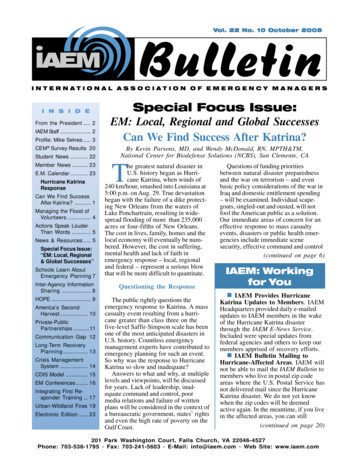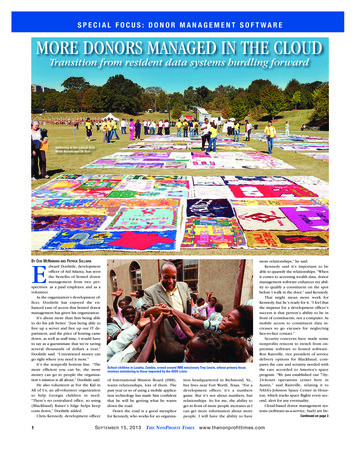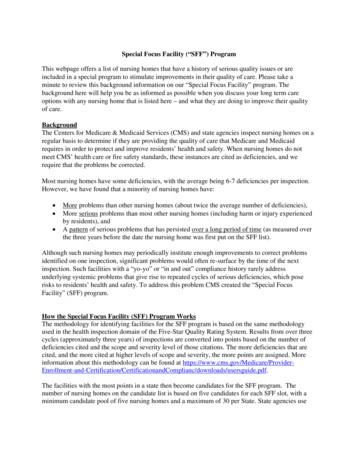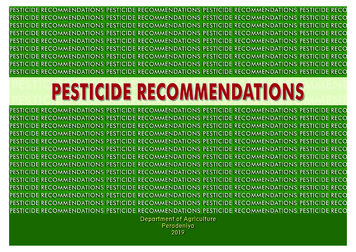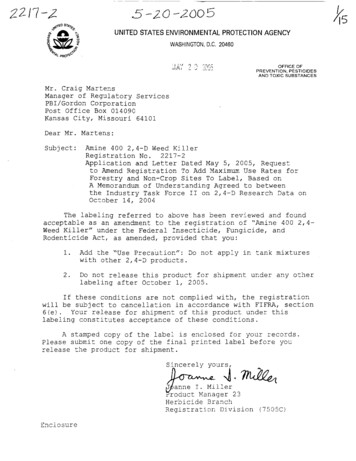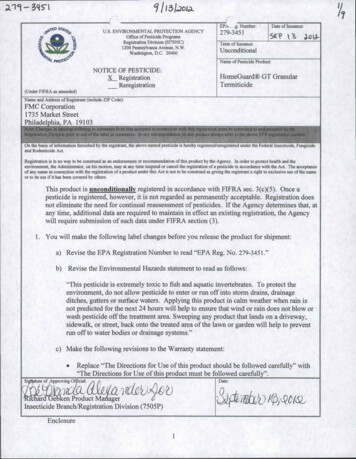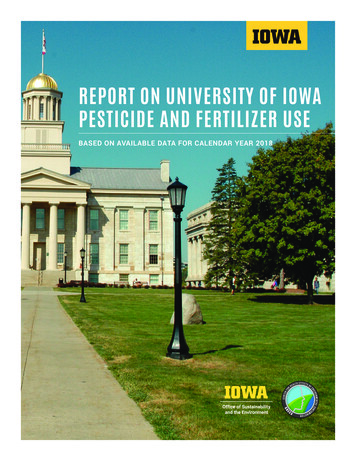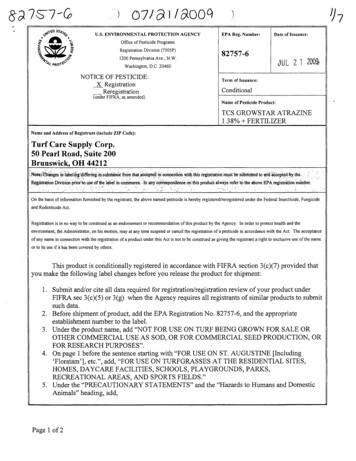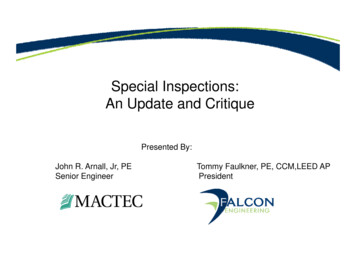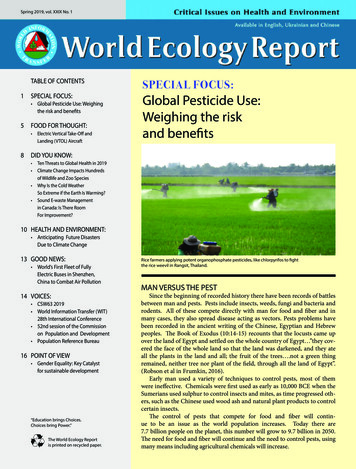
Transcription
Spring 2019, vol. XXIX No. 1TABLE OF CONTENTS1SPECIAL FOCUS:https://cop23.com.fj/ Global Pesticide Use: Weighingthe risk and benefits5FOOD FOR THOUGHT: 8Electric Vertical Take-Off andLanding (VTOL) AircraftSPECIAL FOCUS:Global Pesticide Use:Weighing the riskand benefitsDID YOU KNOW: Ten Threats to Global Health in 2019Climate Change Impacts Hundredsof Wildlife and Zoo SpeciesWhy Is the Cold WeatherSo Extreme if the Earth Is Warming?Sound E-waste Managementin Canada: Is There RoomFor Improvement?10 HEALTH AND ENVIRONMENT: Anticipating Future DisastersDue to Climate Change13 GOOD NEWS: World’s First Fleet of FullyElectric Buses in Shenzhen,China to Combat Air Pollution14 VOICES: CSW63 2019 World Information Transfer (WIT)28th International Conference 52nd session of the Commissionon Population and Development Population Reference Bureau16 POINT OF VIEW Gender Equality: Key Catalystfor sustainable development“Education brings Choices.Choices bring Power.”The World Ecology Reportis printed on recycled paper.Rice farmers applying potent organophosphate pesticides, like chlorpyrifos to fightthe rice weevil in Rangsit, Thailand.MAN VERSUS THE PESTSince the beginning of recorded history there have been records of battlesbetween man and pests. Pests include insects, weeds, fungi and bacteria androdents. All of these compete directly with man for food and fiber and inmany cases, they also spread disease acting as vectors. Pests problems havebeen recorded in the ancient writing of the Chinese, Egyptian and Hebrewpeoples. The Book of Exodus (10:14-15) recounts that the locusts came upover the land of Egypt and settled on the whole country of Egypt ”they covered the face of the whole land so that the land was darkened, and they ateall the plants in the land and all; the fruit of the trees .not a green thingremained, neither tree nor plant of the field, through all the land of Egypt”.(Robson et al in Frumkin, 2016).Early man used a variety of techniques to control pests, most of themwere ineffective. Chemicals were first used as early as 10,000 BCE when theSumerians used sulphur to control insects and mites, as time progressed others, such as the Chinese used wood ash and natural plant products to controlcertain insects.The control of pests that compete for food and fiber will continue to be an issue as the world population increases. Today there are7.7 billion people on the planet, this number will grow to 9.7 billion in 2050.The need for food and fiber will continue and the need to control pests, usingmany means including agricultural chemicals will increase.
CHEMICALS TO CONTROLTHE PESTSMetals were also used as pest control both for field pests andfor treatment of humans, including such dangerous things asarsenic and lead. Paris Green (cooper acetoarsenite) was one ofthe first compounds to be used on a wide scale basis for agricultural pests , it had properties as an insecticide and as a fungicide.Pesticide use changed dramatically just before the SecondWorld War. Dr. Paul Müller, a chemist who was working forthe Swiss chemical company, Geigy found the utility of theinsecticide compound dichlorodiphenyltrichloroethane, better known to us as DDT. DDT was effective as an insecticideand appeared to have low acute toxic properties. Soon after Dr.Müller saw its value to become an important insecticide duringWorld War II. It was effective in controlling the vector for malaria the mosquitoes, and for Typhus, the body louse. Dr. Müller received the 1948 Nobel prize in Physiology or Medicine forhis 1939 discovery of insecticidal qualities and use of DDT inthe control of vector diseases such as malaria and yellow fever.After the war DDT was used extensively in agriculture andbecome one of the most widely used pesticides in history. Itwas used all over the world for the control of a wide range ofpests. It was cheap, effective and long lasting. The last qualitywould ultimately be part of its demise. In addition to beingpersistent, it bioaccumulated in the environment, especially inthe adipose tissue of animals and humans. It was also found tohave a dramatic impact on the endocrine system.THE RISKS OF PESTICIDESBECOME APPARENTWorldwide there are almost 1.8 billion people involved inagriculture, and most of these people use pesticides. (Alavanja, 2009). It is estimated that globally there are about 5.6billion pounds of pesticide used annually and there are some25 million agricultural workers who are poisoned (Jeyaratnam, 1990).One of the most significant events in the recognition ofthe risks associated with pesticide use was the publication ofSilent Spring by Rachel Carson in 1962. Rachel Carson usedthe term biocide to describe a pesticide and she really helpedus frame the issue. Pesticides are, by definition economicpoisons, that are specifically designed to kill something. Inthe case of Silent Spring the DDT interfered with the calciummetabolism in the egg shells of birds the bird’s shells lackedintegrity and would break, there were far fewer birds hatchedover time, hence the name of the book, Silent Spring. Thisendocrine disruption is a common effect of the broad classof compounds the organochlorines which DDT belong to.DDT uses were banned for the most part in the early 1970s.It is legal to manufacture DDT in the US, though it can onlybe exported for use in foreign nations. DDT can only be usedin the US for public health emergencies, such as controllingvector disease. Today, DDT is manufactured in North Korea,India, and China. DDT was canceled in 1972 by the UnitedStates Environmental Protection Agency (EPA). (NationalPesticide Information Center – Oregon State University).World Information Transfer2 World Ecology ReportSpring 2019“It is estimated that globally there are about 5.6 billion pounds ofpesticide used annually and there are some 25 million agriculturalworkers who are poisoned (Jeyarat- nam, 1990)”HOW DO WE BALANCEThe challenge is how do we effectively control the pest, stillmaintain the ecosystem and avoid causing harm to beneficialorganisms? Take for example the use of insecticides that impact pollinators. The same pesticides that are effective for controlling serious harmful insects like the rice weevil (Sitophilusoryzae) and the European corn borer (Ostrinia nubilalis) arealso lethal to beneficial insects like the honey bee (Apis mellifera).Pollinators, including the honey bee, are responsible forseventy-five percent of the world’s food production. In recentyears there have been numerous reports of a general declinein pollinators worldwide, many researchers attribute part ofthis decline to the increase in global pesticide use, in particular newer compounds called neonicotinoids. Neonicotinoidsare highly toxic to a range of insects, including honey beesand other pollinators. But this may be such one factor in avery complex problem, other factors such as nutrition of thebees, changing weather patterns and parasites that attack thebee colonies have also been associated with the decline. Ifthe trend of pollinator decline continues, we will suffer seriousconsequences related to food shortages and famine.Inspecting GMO cotton plants in Hebei Province China. ChineseFarmers use Bt cotton to reduce bollworm and reduce the use ofpesticides
ALTERNATIVE APPROACHESGiven the risks to the environment on increased pesticideuse manufacturers have worked aggressively to make newercompounds that do no persistent in the environment, did notimpact beneficial insects and still provide control at an affordable cost. There has been significant progress in this area. Atthe same time many developing countries still rely on the veryinexpensive older pesticide products and are continuing touse them in large quantities. New pest control technologies,the incorporation of integrated pest management (IPM) andother techniques are effective, but these technologies must bemade available to the developing countries who bear the burden of most of the pest losses and use most of the more dangerous pesticides.GMO CROPSThe other technology that was incorporation of Genetically Modified Crops (GMOs), most commonly known asGMOs into large scale agriculture. Most of the major agronomic crops grown in the world now use GMO seeds. The topseven crops GMO are: corn, soy, cotton, alfalfa, papaya, canolaand sugar beets.There are studies that support the fact that GMO crop production does in fact reduce the use of pesticides. On average,GM technology adoption has reduced chemical pesticide useby 37%, increased crop yields by 22%, and increased farmerprofits by 68%. Yield gains and pesticide reductions are largerfor insect-resistant crops than for herbicide-tolerant crops.Yield and profit gains are higher in developing countries thanin developed countries. (Klümper and Qaim, 2014).In July 2018 USDA ERS released a report on the majoragronomic crops and the percentage of these crops that areIn many countries the women bear the largest burden for taking care of thecrops, the farmstead and the family. Here a woman is taking vegetables to market in Ghana, West AfricaMuch of agricultural production and crop maintenance, such as watering is doneby hand as seen here in Hebei Province China.GMO. Herbicide-tolerant (HT) crops, which tolerate potentherbicides (such as glyphosate, glufosinate, and dicamba),provide farmers with a broad variety of options for effective weed control. Based on USDA survey data, the percentof domestic soybean acres planted with HT seeds rose from17 percent in 1997 to 68 percent in 2001, before plateauingat 94 percent in 2014. HT cotton acreage expanded from approximately 10 percent in 1997 to 56 percent in 2001, beforereaching a high of 91 percent in 2014. Adoption rates for HTcorn grew relatively slowly immediately following the commercialization of GE seeds. However, adoption rates increasedfollowing the turn of the century. Currently, approximately 90percent of domestic corn acres are produced with HT seeds.Insect-resistant crops, which contain genes from the soilbacterium Bt (Bacillus thuringiensis) and produce insecticidalproteins, have been available for corn and cotton since 1996.Domestic Bt corn acreage grew from approximately 8 percentin 1997 to 19 percent in 2000, before climbing to 82 percentin 2018. Bt cotton acreage also expanded, from 15 percent ofU.S. cotton acreage in 1997 to 37 percent in 2001. Currently,85 percent of U.S. cotton acres are planted with genetically engineered, insect-resistant seeds.Increases in adoption rates for Bt corn may be due to thecommercial introduction of new varieties resistant to the cornrootworm and the corn earworm (prior to 2003, Bt corn varieties only targeted the European corn borer). Adoption ratesfor Bt corn may fluctuate over time, depending on the severity of European corn borer and corn rootworm infestations.Similarly, adoption rates for Bt cotton may depend on theseverity of tobacco budworm, bollworm, and pink bollworminfestations. (USDA 2018). Corn, cotton and soy have gonefrom near 0 percent in 1996 to almost 95 percent in 2018. TheISAAA estimates that in 2017 there were 189.9 million hectares of genetically modified crops grown.World Information TransferWorld Ecology Report 3Spring 2019
SO, WHAT IS NEXT?The real question is, how do we grow enough food for almost 10 billion people without harming the environment andourselves. The US NIH NCI has shown it is massive Agricultural Health Study that there is evidence of increased incidence of cancer of the prostate, lung, colon, pancreas, bladder,leukemia, and multiple myeloma with increasing lifetime exposure to certain pesticides.In March 2015, IARC (International Agency for Researchon Cancer (WHO) classified glyphosate as “probably carcinogenic to humans” (Group 2A). This was based on “limited”evidence of cancer in humans (from real-world exposures thatactually occurred) and “sufficient” evidence of cancer in experimental animals (from studies of “pure” glyphosate). IARCalso concluded that there was “strong” evidence for genotoxicity, both for “pure” glyphosate and for glyphosate formulations.The IARC Monographs evaluation is based on the systematicassembly and review of all publicly available and pertinentstudies, by independent experts, free from vested interests. Itfollows strict scientific criteria, and the classification system isrecognized and used as a reference all around the world. Thisis because IARC evaluations are based on independent scientific review and rigorous criteria and procedures. To reachthese conclusions, IARC reviewed about 1000 studies. Someof the studies looked at people exposed through their jobs,such as farmers. Others were experimental studies on cancerand cancer related effects in experimental systems. (WHOIARC 2015). Glyphosate is one of the most widely used herbicides in the world, it was first used in the agricultural marketby Monsanto in 1974. Glyphosate became a very importanttool in the development of GMO crops because of the abilityof plant breeders to modify the soybean to tolerate the herbicide. Current glyphosate-resistant crops include soy, maize(corn), canola, alfalfa, sugar beets, and cotton. With the largeincrease in GMO crops that are glyphosate tolerant has comea large increase in the use of glyphosate, with the IARC designation the question becomes does the use of these GMOsPesticide Applicators often wear little or no protective equipment (PPE) whenmaking a pesticide application as seen here in Xiamen China.increase the risk to human health based on the increase in theuse of this herbicide. Remember, too that in the developingworld, countries have minimal pesticide regulation, the emphasis is often on the production of the crop and not of theprotection of the farmers.”DDT was an effective insecticide.and was used extensively inagriculture . all over the world”Chemical manufactures have made an effort in the pastdecade to increase the product stewardship programs theyhave in developing countries to train and educate growers andapplicators the risks as well as the benefits of using these crops.There needs to be a much greater emphasis on these programsto ensure that rural communities, not just the farmers andpesticide applicators, but all of the people in these communities are made aware of the risks associated with increasedpesticide use. Governments and universities must also takethe lead in educating the local people on an integrated approach, new varieties, timing, beneficial insects, crops rotation, and organic agriculture are also options to reduce pesticide use overall and to ensure that when these compounds areused they are used carefully, prudently and economically withhealth and safety being the primary goal.Author: Dr. Mark Gregory RobsonBoard of Governors Distinguished Service Professor, Editor in Chief– Human and Ecological Risk Assessment. Rutgers University School of Environmental and Biological SciencesWhile chemical methods are used worldwide, some traditional methods such asthe scarecrow are still used in some countries, here in Mỹ Tho, Vietnam.World Information Transfer4 World Ecology ReportSpring 2019REFERENCESM. Alavanja. Re Environ Health 24(4):303-309. 2009.J. Jeyaratnam. WHO Acute pesticide poisoning : a major globalhealth problem. 43 (3) 139-144 1990. W. Klümper and M. Qaim,PLOS ONE https://doi.org/10.1371/journal.pone.0111629. 2014.M. Robson, et al. In Environmental Health Third Edition JosseyBass. Pp 477 – 501. 2016. WHO IARC Monograph 112. 2015.
FOOD FOR THOUGHTElectric Vertical Take-Offand Landing (VTOL) AircraftAngelenos, the name the citizens of Los Angeles proudlyinherit, are set back 104 hours and 9.7 billion each year dueto urban traffic congestion. Such tribulations are not unique toSouthern California. For decades, a combination of sustainedeconomic growth and cheap fuel allowed the car to drive urbandevelopment around the world. Today, the car-centric urbandevelopment model is becoming outmoded. Available urbanarea for supply-side infrastructure development is diminishing and cities such as London, Sydney, Tokyo and Mumbaiare feeling the growing pains. This is a direct consequence ofwidespread urbanization and a swelling global middle class.have seen a dramatic fall in the past decade, driven by electricvehicle and mobile telecommunications investment. Batteryenergy and power densities are also key metrics. Both haveseen 10% improvements year-on-year. Another technological development is pilot control augmentation. Today’s techgiants, notably Google, Facebook, Apple, Baidu, Tencent andAmazon and prescient car manufacturers such as Telsa, BMWand Volvo, have driven significant advancements in ArtificialIntelligence (AI). For eVTOLs, AI would reduce pilot workload and overall accident risk appreciably. Smart eVTOL computers could learn how to avoid dangerous weather or recognize incoming birds and other eVTOL aircraft more reliablythan a human could. In the future, eVTOL computers couldunderstand the nature of piloting errors and pre-empt poorhuman decisions. By utilizing a medley of radar, camera, LIDAR and IR sensors, on-board computers could peer throughrain, fog and darkness, improving an eVTOL’s reliability. TheInternet of Things (IoT) will allow eVTOLs to learn collaboratively, sharing flight data and best safety practices. Finally, byutilizing distributed electric propulsion and innovative flightconfigurations, eVTOLs would be substantially quieter thanhelicopters and be acoustically on-par with common urbanbackground noises such as passing trucks, trains or a two-lanehighway. [2]Figure 1: Global urban population of countries categorized by income bracket, 1961 - 2017. [1]A whole host of technological solutions to mitigate thebaleful effects of urbanization have been proposed, from predictive traffic analytics powered by Artificial Intelligence (AI)to car-sharing business models backed by ubiquitous internetconnectivity. However, one emerging technology, the electricVertical Take-off and Landing (eVTOL) aircraft, has caughtour attention. This article seeks to explore the engineering feasibility of the eVTOL machine, identify its use cases, examineits benefits and concomitant risks and evaluate the broaderknock-on effects of an eVTOL revolution. Aeronauts aroundthe world are enlivened by the idea of aviation innovation anddecentralization. The opposite may be said for wonted municipal leaders. However, if we are to surmount the herculean issues that face our 21st century urban societies, innovation andtechnological pluck will need to be habitual.When in Doubt, Look UpFrom an engineering standpoint, the technology that underpins eVTOL aircraft is certainly available. Battery pricesFigure 2: Uber Elevate eVTOL aircraft concept [5].But eVTOLs are not a panacea for urban mobility. Depending on what future regulation permits, they will likelyplay a crucial role in point-to-point long-distance transit inWorld Information TransferWorld Ecology Report 5Spring 2019
the emerging mobility ecosystem that includes shared autonomous electric vehicles, eBikes and revamped public transportnetworks. Vertical mobility may be organized in two categories: intra-city and inter-city transportation. In sprawling cities such as Los Angeles or Beijing, sub-eighty-kilometer intracity flights will connect suburban districts with urban ones.They promise to assuage congestion but also current urbanhousing woes by trimming suburban commute times. Thiswould stimulate residential projects outside traditional cityboundaries. Inter-city flight, ranging from 80 to 160 kilometers, will connect medium-sized cities as one urban ecosystem. Commuting between cities will become possible and reduce the need for inflexible newly laid infrastructure.Special mission operations for eVTOL aircraft should notbe overlooked. eVTOLs outcompete helicopters on sustainability, cost, noise, speed and ease of operation, only lackingin payload capacity. Expedited trans
The Book of Exodus (10:14-15) recounts that the locusts came up over the land of Egypt and settled on the whole country of Egypt ”they cov- . New pest control technologies, the incorporation of integrated pest management (IPM) and other
